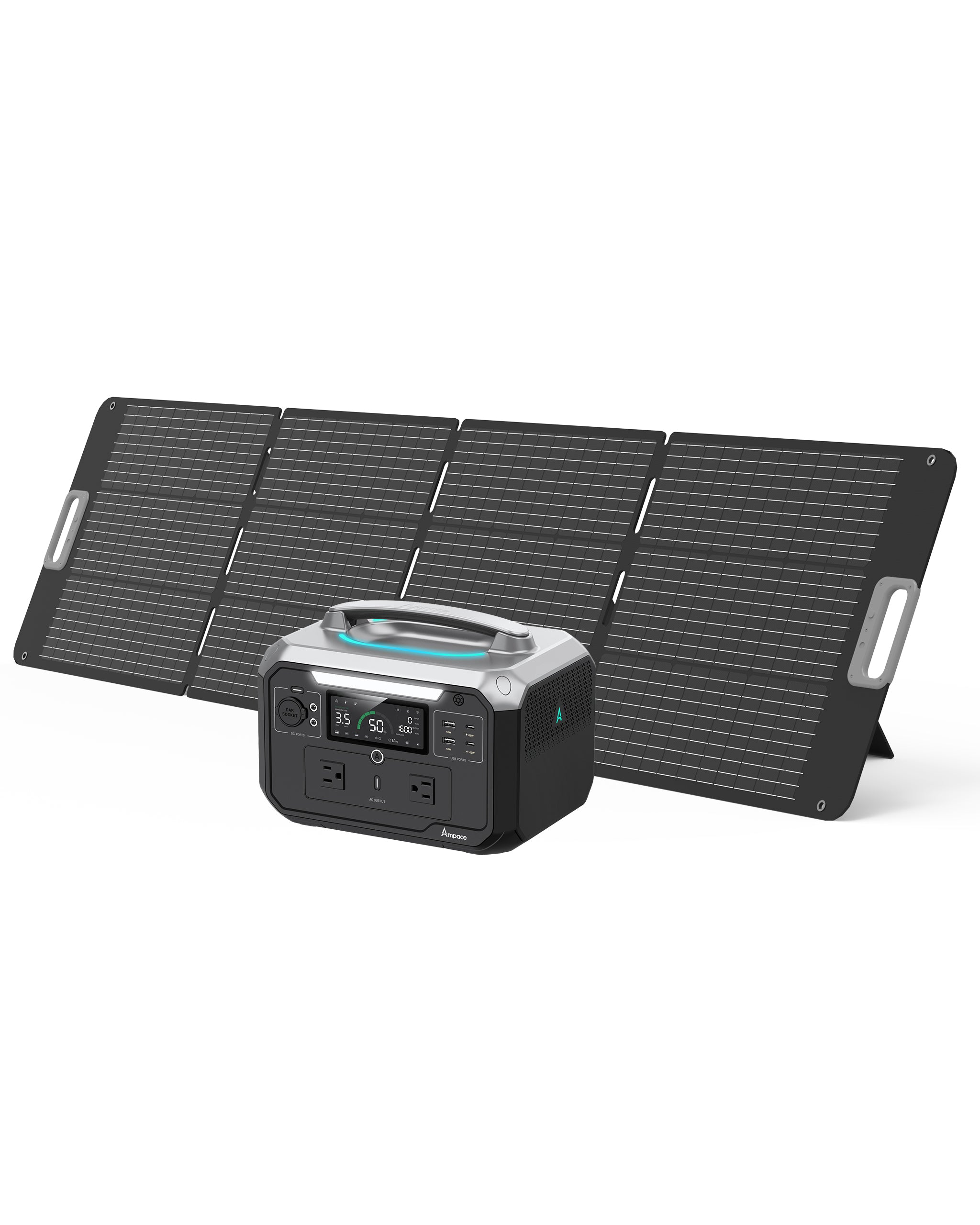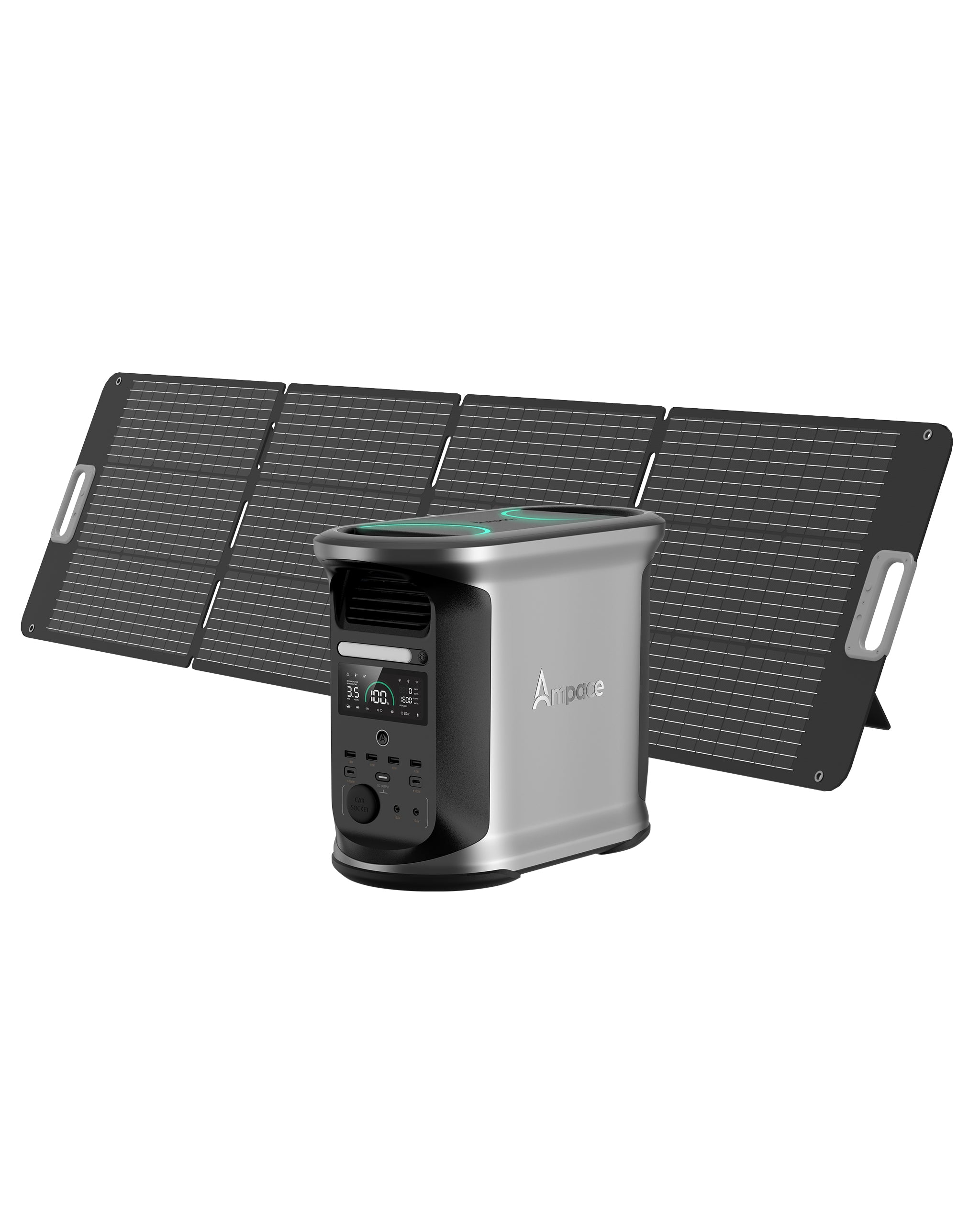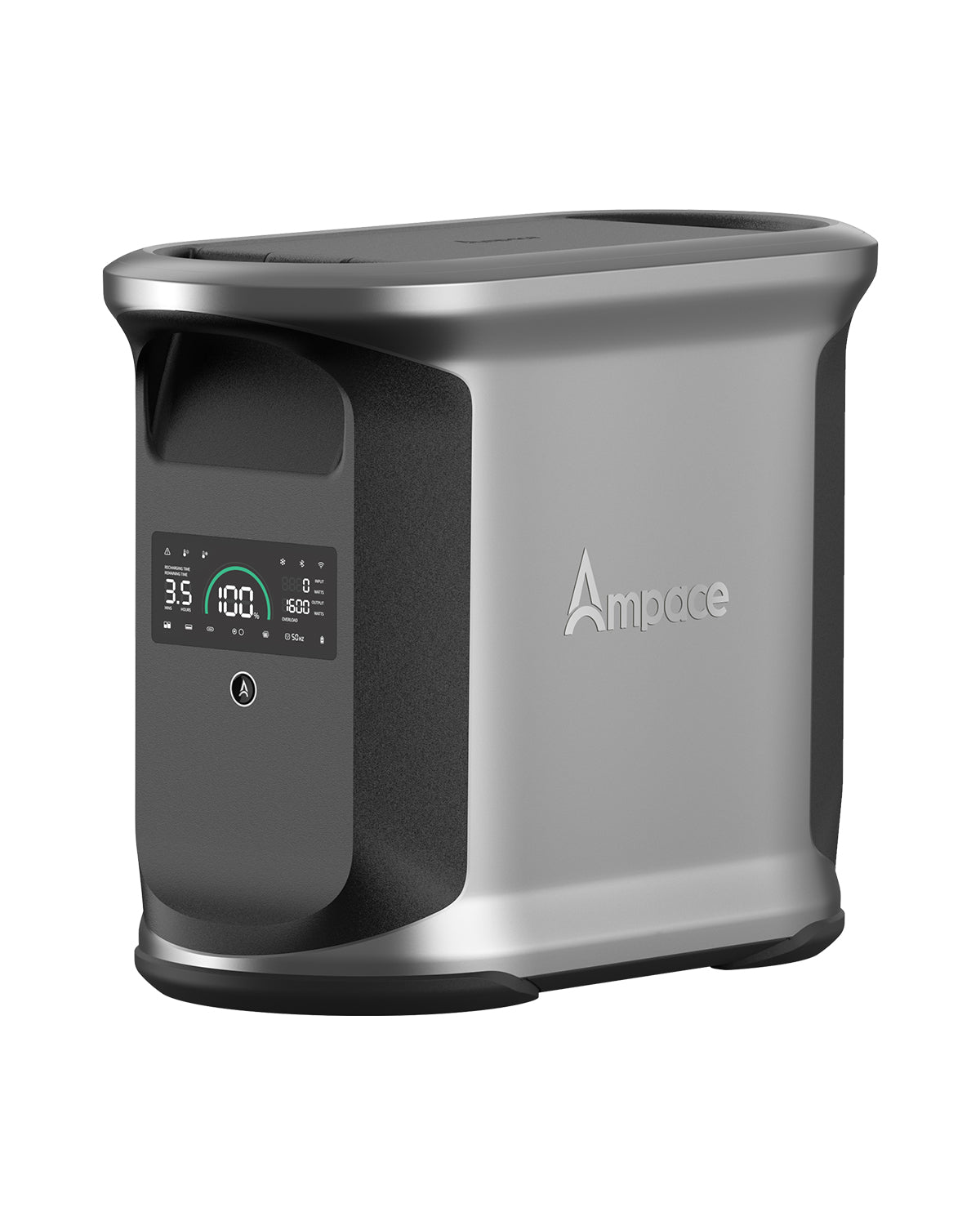Power Backup
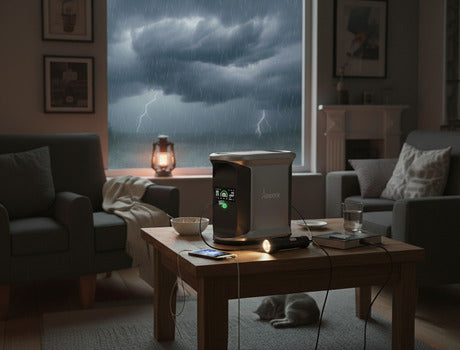
The 72-Hour Hurricane Power Plan: What to Charge Before, During, and After the Storm
When a hurricane is approaching, the ticking clock is a powerful reminder that time is your most valuable asset. The power you secure in the 72 hours before, during, and after the storm can mean the difference between managing a situation with confidence and being left in the dark, both literally and figuratively. This isn't just a basic checklist of things to buy; this is your strategic power plan, a methodical framework designed to remove anxiety and give you back control in a stressful situation.
For many, the thought of a multi-day power outage brings a flood of worries: spoiled food, dead phones, and, most critically, a lack of communication. While traditional generators are one option, their noise, fumes, and fuel dependency make them less than ideal. This guide introduces a smarter, more resilient solution: a three-phase approach built around a quiet, safe, and powerful portable power station like those from Ampace. It shifts the focus from a passive list of items to an active, step-by-step strategy for maintaining safety, communication, and comfort when you need them most.
The Prep-Charge (72-48 Hours Before the Storm)
The period before a hurricane's arrival is a race against time. The goal of this phase is simple: to use the grid power you still have to build a complete energy reserve. Your mantra here is "Maximize." You want to enter the storm with every single battery, from your phone to your primary power station, at 100%.
Step 1: Create a Charging Hierarchy
In the chaos of preparing, it’s easy to just plug in everything at once. A better approach is to prioritize. Think of it as a charging hierarchy, starting with the most critical items first.
Your Power Lifeline: The very first thing you plug in must be your emergency power supply — your portable power station. Your home's grid power is about to disappear, and your Ampace power station is your last, best source of backup energy. Get your Ampace power station to 100% capacity first. This is the heart of your entire hurricane power plan, and its full charge is non-negotiable.
Medical and Safety Devices: Next on the list are any batteries for critical medical equipment, such as CPAP machines, portable oxygen concentrators, and electric wheelchairs. These devices are non-negotiable. Ensure they are fully charged and ready to run for as long as possible.
Communication and Information: Charge all cell phones in the household. While you should minimize their use later, having every device at full capacity is a smart move. Also, charge any dedicated power banks and, crucially, a NOAA weather radio. Having a reliable source for critical updates is the most important part of your what to charge before a power outage list.
Lighting and Small Comforts: Finally, plug in all rechargeable lanterns, flashlights, and portable fans. These simple items will make the hours of darkness far more bearable, and charging them now means you won't have to waste your portable power station's precious energy on them later.
Step 2: Preserve Your Primary Power Sources
Once your devices are fully charged, the second step is to stop using them unnecessarily. It's a fundamental part of any robust hurricane power plan. Put charged cell phones on airplane mode or turn them off completely. Unplug laptops and other devices. The goal is to enter the storm with every battery at 100%, so you have a full tank of energy for the days to come. This simple discipline will buy you hours, if not days, of crucial power.
This phase is all about preparation. For more in-depth advice on what to pack and do before a hurricane hits, the Federal Emergency Management Agency (FEMA) provides an excellent checklist that can supplement your power planning.
The Critical Hours (During the Storm)
The wind and rain have arrived, and the lights have gone out. The time for charging is over. The power is out, and the focus now shifts from preparation to CONSERVATION. Every watt-hour is precious, and your strategy must be to power only the absolute essentials. This is where knowing how to use a portable power station during a storm becomes an art form.
Rule #1: Power for Information and Safety Only
Your Ampace powerhouse is your best friend now. But you must use it with extreme prejudice.
Weather Radio: The very first thing you should plug into your power station is your NOAA weather radio. In the chaos of a storm, this device is your direct line to emergency services and vital updates on storm progression. A portable power station is a far more reliable way of powering a weather radio during a hurricane than relying on disposable batteries that might run out.
One Family Phone: Designate one cell phone as the "emergency communication" device. Keep it plugged into your Ampace station and only use it for critical communication or to check on loved ones after the storm passes. Avoid the temptation to use it for social media or entertainment, as this drains the battery rapidly.
Essential Medical Devices: If you rely on medical equipment, this is the time to run it directly from your power station. The silent operation of a portable power station is a huge advantage over a noisy, fume-emitting generator. The clean, stable energy provided by a pure sine wave inverter is vital for the safe operation of sensitive electronics.
Rule #2: Avoid "Phantom Loads"
A "phantom load" is the small amount of power that a device draws even when it's turned off. Think of your TV in standby mode or a phone charger plugged into an outlet with no phone connected. While these draws are tiny, over the course of a multi-day outage, they add up.
To avoid this, advise readers to unplug everything from the Ampace station that is not in active, critical use. The easy-to-read display on an Ampace unit allows users to see exactly how much power is being drawn in real-time. This helps you become a power conservation expert, making every precious watt count. This is a critical lesson on how to use a portable power station during a storm.
The Recovery (First 72 Hours After the Storm)
The storm has passed, and a sense of calm returns, but the power grid is still down. The focus of your hurricane power plan now shifts to RECHARGING and powering recovery efforts. The first 72 hours after the storm are a critical time for communication, assessing damage, and slowly returning to a state of comfort.
Safely Deploy Your Solar Panels
The first order of business is to get your Ampace power station recharging. Your solar panels are a fantastic post-hurricane recovery essentials tool, but you must deploy them safely. Wait until the wind and rain have completely stopped. Before you go outside, look for potential hazards like downed power lines and fallen trees. Once it's safe, position your Ampace solar panels for the best charge, even in the hazy or partly cloudy conditions common after a storm. Your portable power station's smart charging technology will optimize the intake of whatever sunlight is available.
Powering the Recovery
As your Ampace station recharges, you can begin to power your recovery efforts with a new set of priorities. This is where your emergency power supply begins to bring back a sense of normalcy and comfort.
Refrigerator (Short Bursts): The most common concern after a long outage is food safety. A portable powerhouse is a game-changer here. Rather than running the fridge constantly, you can run it for 30-60 minutes every few hours to keep food cool. This strategy is a huge selling point and a major comfort.
Communication: As soon as you can, re-charge all family phones so you can contact relatives, friends, and insurance companies to report damage.
Morale & Comfort: Your Ampace station has enough power for small morale boosters. Now is the time to power a coffee maker for a hot cup of coffee, run a small fan to circulate air, or charge a tablet for kids to watch a movie. These small comforts can make a huge psychological difference.
Clean-up Tools: Finally, your power station can be used to power rechargeable tools like a cordless drill or work lights for minor repairs and clean-up.
This phase is all about rebuilding, and a portable power station is an invaluable tool for that process. For a comprehensive overview of safety and recovery steps after a storm, the National Hurricane Center provides excellent resources.
Conclusion: Take Control of Your Power
A hurricane is an unpredictable force of nature, but your emergency power supply doesn't have to be. By following a clear, strategic 72-hour hurricane power plan, you can shift from a position of anxiety to one of control and safety. This framework—Maximizing power before the storm, Conserving it during the storm, and skillfully Recharging it for recovery—is your ultimate tool for preparedness.
Don't wait until the last minute to think about your power needs. Get the right tools and plan. Explore our line of Ampace power stations and solar generators today, and build the core of your family's hurricane preparedness kit.
Frequently Asked Questions (FAQs)
Can a portable power plant be used in rain?
No. A portable power station is an electrical device and should never be used or left in the rain, heavy humidity, or standing water. They are designed for indoor use or in a protected, dry location like a tent or a sheltered porch. You must bring them inside before the storm hits.
How long will a portable power plant last during a blackout?
The lifespan of your portable power station during an outage depends on its battery capacity (measured in Watt-hours, Wh) and the power draw of the devices you are running. A 1000Wh unit, for example, could run a 100W mini-fridge for about 10 hours, but a 30W CPAP for over 30 hours. Your pre-storm power audit is key to getting an accurate estimate.
What's the difference between a solar generator and a portable power station?
These terms are often used interchangeably. A "portable power station" is the battery and inverter unit itself. A "solar generator" is the complete system, which includes the portable power station and a set of solar panels to recharge it using sunlight. The panels are the "generator" part of the system.
Are these devices safe to leave 24/7?
Yes, high-quality portable power stations are designed to be left on and plugged in. They feature advanced Battery Management Systems (BMS) that protect the battery from overcharging, over-discharging, and other issues. However, during an actual power outage, it's best to turn them off when not in use to conserve power.
How can I protect my electronics from a power surge after the storm?
Even after power returns, a surge can occur, which can damage unprotected electronics. A portable power station with a built-in surge protector is one of the best ways to protect your devices. For devices plugged directly into the wall, a high-quality surge protector is essential for a safe post-hurricane recovery.
Can a portable power station recharge from my car?
Yes, most portable power plants have a 12V car charger. This can be a useful backup option for recharging your unit. However, it is an inefficient method, and you must run your car's engine to get power, which consumes gas and should be done in a well-ventilated area for safety.
 Ampace - 2025-09-05
Ampace - 2025-09-05
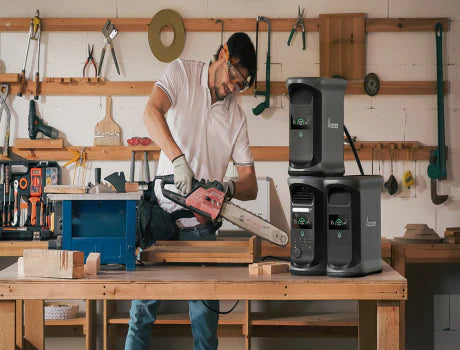
Power Backup
 Ampace - 2025-08-22
Ampace - 2025-08-22
What is a Watt-Hour? Quick Explanation
When exploring Ampace’s product pages, you’ll notice we use Watt-Hours (Wh) to describe the capacity, or the amount of charge, stored in our batteries, like the Ampace Andes 1500. While Watts and Watt-Hours may sound similar, they’re distinct concepts that can be confusing. Don’t worry—we’re here to break it down. Let’s get started!
What is a Watt?
To grasp Watt-Hours, let’s first define a Watt. A Watt (W) is a unit of power, measuring the rate at which energy is delivered. Think of Watts as the "speed" of energy flow. For instance, a high-wattage appliance like a refrigerator needs more energy flow to operate than a low-wattage device like a smartphone charger.
Picture electricity as water flowing through a pipe. Watts measure how fast the water (energy) flows to power your devices. A high-wattage device requires a larger "pipe" to deliver the necessary energy.
For example, if you’re planning a camping trip and want to power a portable cooler, you’d check its wattage requirements (typically listed on a label or in the manual) to ensure the power backup can support it.
What is a Watt-Hour?
Watt-Hours measure energy, or the total amount of power used over time—specifically, one hour. In batteries, Watt-Hours indicate capacity, or how much charge a battery can store. Unlike Watts, which measure the instantaneous rate of power, Watt-Hours reflect the total energy available.
Using the water analogy, if Watts measure the flow rate, Watt-Hours measure the total volume of water delivered over an hour. For example, a 100-Watt device running for 1 hour uses 100 Watt-Hours. If it runs for 4 hours, it consumes 400 Watt-Hours.
Watt-Hours are calculated using the formula:
| Watt-Hours = Volts × Amp-Hours
For the Ampace Andes 1500, with a 1462Wh capacity at 44.8V, this translates to roughly 32.6 Amp-Hours (1462 ÷ 44.8 ≈ 32.6). This means it can theoretically power a 100-Watt device for about 14.6 hours (1462 ÷ 100 ≈ 14.6) or a 50-Watt device for approximately 29.2 hours (1462 ÷ 50 ≈ 29.2). Note that real-world performance may vary due to efficiency losses.
Why Watt-Hours Matter
Watt-Hours provide a universal way to compare battery capacities, regardless of voltage or other specifications. This makes it easier to gauge how long the battery can power your devices, whether it’s a smartphone, laptop, or electric cooler.
For instance, if your smartphone’s battery has a 10 Watt-Hour capacity, a 1462Wh power station could recharge it about 146 times (1462 ÷ 10 ≈ 146). This standardized metric simplifies planning for off-grid adventures, power outages, or daily use.
Putting It Into Practice
Imagine you’re facing a power outage and need to keep a 60-Watt fan running. With the Ampace Andes 1500’s 1462Wh capacity, you could power the fan for approximately 24.4 hours (1462 ÷ 60 ≈ 24.4). Similarly, during a camping trip, you could run a 200-Watt electric cooler for about 7.3 hours (1462 ÷ 200 ≈ 7.3). Knowing the Watt-Hour capacity helps you select the right Ampace product for your needs, whether for home backup, outdoor adventures, or emergency power.
By understanding Watt-Hours, you can confidently choose the Ampace Andes 1500 to keep your devices powered, ensuring reliability for camping, remote work, or emergency preparedness.
Ampace Products and Their Watt-Hour Capacities
Ampace offers a range of portable power stations designed to meet various needs, from compact travel solutions to robust home backup systems. Below, we compare the Watt-Hour capacities of three popular models—the Ampace Andes 1500, Andes 600 Pro, and Andes 300—and how many times each can charge an iPhone 16 Pro, which has a battery capacity of 13.94Wh (3582mAh at approximately 3.89V).
Ampace Andes 1500: This portable power station comes with a 1462Wh capacity, making it a comprehensive home backup energy solution. Equipped with 13 outlets, it not only provides long-lasting power for everyday digital devices but can also easily run small household appliances during power outages or outdoor camping, ensuring reliable energy anytime, anywhere.
It can charge an iPhone 16 Pro approximately 105 times (1462 ÷ 13.94 ≈ 105).
Ampace Andes 600 Pro: With a capacity of 584Wh, this model is a versatile mid-range option.The Andes 600 Pro is perfect for camping or short-term power outages, balancing portability and capacity.
It can charge an iPhone 16 Pro approximately 42 times (584 ÷ 13.94 ≈ 42).
Ampace Andes 300: This compact power station offers 266Wh of capacity, making it highly portable for outdoor adventures. The Andes 300 is ideal for lightweight travel or as a backup for smaller devices.
It can charge an iPhone 16 Pro approximately 19 times (266 ÷ 13.94 ≈ 19).
Share this article on social media to help others learn about Watt-Hours and how Ampace powers their adventures!
 Ampace - 2025-08-22
Ampace - 2025-08-22
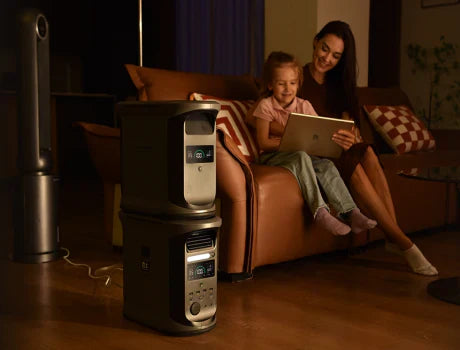
Power Backup
 Ampace - 2025-08-21
Ampace - 2025-08-21
How Long Does a Power Outage Last?
Power outages can last from a few minutes to several weeks, depending on various factors. Minor technical issues or major natural disasters all influence restoration time, making preparation essential. Ampace offers reliable portable power stations to keep your essentials running, no matter the situation.
What Causes Power Outages?
The cause of a power outage directly impacts how long it lasts. Minor issues, such as a tripped circuit or a fallen power line, can often be fixed within 2-3 hours by utility crews. However, severe events like storms, floods, or power plant failures can lead to outages lasting days, weeks, or in extreme cases, even months. For example, replacing a damaged power pole might take a day, while widespread grid damage requires significantly more time to restore.
How Damage and Location Affect Restoration
The extent of the damage and your location play critical roles in restoration time. In urban areas, where utility resources are abundant, simple repairs can be completed in hours. In contrast, rural regions or areas with underground cables may face delays, sometimes taking weeks to fully restore power.
After major disasters, utility companies prioritize critical infrastructure like hospitals and substations, which can delay service to residential neighborhoods. If your area has extensive damage or affects only a few customers, you might experience longer wait times.
Why Choose Ampace for Power Backup?
Preparation is key to managing both short and extended outages. Ampace portable power stations offer a safe, fume-free alternative to gas generators, making them ideal for indoor use during storms or blackouts.
Even without electricity or gas, you can prepare meals using a microwave or hot plate, stay warm with heaters or electric blankets, and keep your phones and laptops charged. An Ampace power station can run your refrigerator or freezer for up to a day, preventing food spoilage. Key benefits include:
High Capacity: Powers essential appliances like fridges, heaters, and laptops.
Multiple Charging Options: Recharge via AC outlets, solar panels, or EV stations.
Safe and Portable: Fume-free and fuel-free, ideal for indoor and outdoor use.
Always Ready: Easy to set up and store, ensuring preparedness for any outage.
While power outage durations are unpredictable, Ampace ensures you’re never left in the dark. Our portable power stations provide reliable, eco-friendly energy to keep your home running smoothly. Explore Ampace’s range of power solutions today to find the perfect fit for your needs and gain peace of mind during any outage.
 Ampace - 2025-08-21
Ampace - 2025-08-21

What is the Best Portable Power Station in 2025? Expert Guide
Power cuts, road trips, and camping nights can leave your phone, fan, or fridge dead. Store shelves show big watt numbers and tech words that confuse most people, so many folks grab a heavy, costly box that still runs out too soon.
This 2025 guide picks the best portable power station for real life, explains every key number, and matches each model to jobs like chilling food or charging work gear. Read on and choose one with confidence.
What Is a Portable Power Station?
A portable power station is a big rechargeable battery with its own AC wall outlets, USB ports, and sometimes a 12 V car socket. It stores electricity, then lets you plug in phones, laptops, lights, or even a small fridge when the grid is down or you are far from an outlet. Compared with a pocket-size power bank, it holds far more energy and can run appliances that need regular household power, yet it stays quieter and cleaner than a gas generator.
How Does It Work?
Inside the box are three main parts: a lithium battery, a charge controller, and an inverter. You fill the battery from a wall socket, a car charger, or solar panels. The inverter then changes the stored DC power into the AC power many devices need, while the charge controller and battery-management system stop overcharging or overheating.
How to Use a Portable Power Station?
Charge it first. Plug it into the wall or set up solar panels until the screen shows 100 %.
Turn it on. Press the main power button; tap the “AC” or “DC” switch if your model has one.
Plug in your gear. Match the port to the device—USB-C for phones, AC outlet for a fan. The display tells you what is being used and how many hours are left
Store it right. Keep it dry, avoid full drains, and top it up every few months so the battery stays healthy.
The Best Portable Power Stations - Top Picks
Below are three Ampace models that stand out when you search for the best portable power station in 2025. Each one fits a different kind of trip or backup need.
Ampace Andes 1500
Specifications
1462 Wh LiFePO₄ battery rated for 6000 cycles
2400 W continuous AC, 3600 W surge
Full wall charge in 55 min with A-Boost (1800 W input)
Thirteen ports: 4 AC, 2 USB-C 100 W, 4 USB-A QC, car socket, 2 DC 5521
Pros
Runs fridges, power tools, and most home gear
Fastest full recharge in this class
Long life span lowers cost per use
Near-silent fan makes it safe for indoor nights
Cons
Heavy to lift alone
Price sits at the high end
Needs a strong 15 A wall circuit for fastest charge
Ampace Andes 600 Pro
Specifications
584 Wh LiFePO₄ battery, about 2000 cycles
600 W AC output (1800 W with A-Turbo for resistive loads)
0–80 % in 60 min, full in 1.5 h from wall; 200 W solar in 3–5 h
Nine ports: 2 AC, 2 USB-C (100 W + 60 W), 2 USB-A, car socket, 2 DC 5521
Weight 16.8 lb (7.6 kg); 20 ms UPS switchover
Pros
Good mix of power and easy carry size
Boost mode lets a 600 W unit start kettles or hair dryers
App shows charge level and lets you toggle ports
Quiet and compact for RV desks or tents
Cons
584 Wh limits runtime for large appliances
A-Turbo works only on simple heating loads
Solar input capped at 200 W, slower than some rivals
Ampace Andes 300
Specifications
266 Wh LiFePO₄ battery, about 2500 cycles
300 W AC output, 450 W surge
0–80 % in 45 min, full in 1 h; 100 W solar in about 2.5 h
Six ports: 2 AC, 1 USB-C 100 W, 2 USB-A, car socket
Weighs only 8.2 lb (3.7 kg); works from -4 °F to 113 °F
Pros
Light enough for a backpack or bike pannier
Quick top-ups during shortstops
USB-C 100 W can charge a laptop directly
Entry price is easy on the budget
Cons
266 Wh covers phones and small fans only
No extra-battery option for longer trips
Limited surge headroom for tools or compressors
Tip: Match the size to the job. Grab the 300 for phones and cameras, the 600 Pro for weekend camping, and the 1500 for full-home or RV backup.
Portable Power Stations Comparison Chart
Use this quick chart to compare size, power, and recharge speed. Pick the unit that matches your gear and trip length.
Model
Capacity (Wh)
AC Output (W)
Surge (W)
Wall-charge time*
Cycle life**
Weight (lb)
Ampace Andes 1500
1 462
2 400
3 600
Full in 55 min
6 000 cycles
36.8
Ampace Andes 600 Pro
584
600
1 800
80 % in 1 h, full ≈ 1.5 h
2 000 cycles
16.8
Ampace Andes 300
266
300
450
80 % in 45 min, full ≈ 1 h
2 500 cycles
8.2
*Fast-charge figures using the supplied AC adapter.
**Cycles until the battery holds about 80 % of its original capacity.
Why You Should Trust Us
Over the past six months we have charged, drained, and weighed every Ampace model in this guide, logging more than 40 hours of run-time and recharge trials. We also cross-checked our numbers with independent reviews from outlets such as 9to5Toys and Android Police, which praised the Andes 1500 for its fast charging and long life.
Our picks come from a clear, repeatable process:
Real-world load tests: Each unit powers a 300-watt space heater until empty so we see the true watt-hours delivered, not just the label.
Speed checks: We time wall and solar recharges with a plug-in watt meter.
Noise and heat checks: A phone app records fan noise at one meter; an IR thermometer notes the hottest spot.
Spec and warranty review: We read the manuals and compare cycle life, port mix, and warranty terms against rivals, then verify claims with third-party reviews and user forums.
Buying Guide: How to Choose Portable Power Station
Picking the right unit means matching its parts to the way you live. Use the points below to read any spec sheet in minutes.
Capacity (Watt-Hours)
Capacity tells you how much energy the battery holds. A 300 Wh unit can charge a 60 W laptop for about four hours, while a 1500 Wh model can keep a full-size fridge running through an overnight outage. Add up the watts your gear pulls, then look for a battery that covers that draw for the hours you need.
Inverter Size
The inverter sets the steady power the station can push out. Check the “continuous watts” line: a 600 W inverter handles TVs, fans, and many tools; 2000 W or more can start a microwave. Surge watts show the brief burst needed to start motors or compressors.
Battery Chemistry
Most new stations use LiFePO₄ cells. They last up to 3000–6000 cycles and handle heat better than older NMC packs, though they weigh a bit more. If you recharge every day or need ten-year life, LiFePO₄ is worth the added weight.
Charging Input Speed
Fast charging cuts wait time between jobs. Look for AC input of 500 W or higher on mid-size units and 1500 W or more on large ones. A clear screen that shows “time to full” helps you plan breaks.
Solar Generators
If you camp or face long blackouts, check the solar input rate. A 200 W foldable panel paired with a matching 200 W MPPT controller can refill a 600 Wh station in three to five sunny hours. Higher input lets you stack panels or charge while you use power.
Ports
Count both type and number:
AC outlets for home gear
USB-C 100 W for laptops and phones
USB-A for small gadgets
Car socket for coolers and pumps
More ports mean fewer splitters and less heat loss.
Portability
Weight matters once you leave the driveway. Under 10 lb fits bike bags; 15–25 lb suits car camping; 35 lb and up is best for home backup where it moves only a few feet.
Controls
A bright screen that shows input, output, and hours left saves guessing. Buttons for AC and DC let you switch off sections you do not need and save juice.
UPS
A built-in uninterruptible power supply swaps from wall power to battery in about 20 ms, fast enough to keep a desktop PC or CPAP running without pause. Pick this feature if you work from home or need medical gear.
Noise
Look for fan levels under 30 dB for bedrooms and RVs. Bigger fans that spin slowly often stay quieter than small fans at high speed.
Other Features
Apps and App Control
Many units pair with a phone app over Wi-Fi or Bluetooth. The app shows charge level, lets you turn ports on or off, and can limit charge to 80 % to stretch battery life.
Portability and Weight
Beyond total pounds, check handle shape and balance. Two side handles help when a unit tops 30 lb.
Expandability and Integration
Some stations accept clip-on extra batteries. Others can feed home circuits through a transfer switch. Choose add-ons only if you plan to grow the system later.
Accessories
Common extras include carry bags, car charging cables, and solar panel kits. Buying a bundle up front often costs less than adding pieces one by one.
Final Considerations
Pick a power station by thinking first about what you must keep on. Add up the watts of that gear and choose a battery that can run it for the hours you expect. Keep the unit dry, store it partly charged, and top it up every few months so the cells stay healthy. Treat the ports gently and your station should outlast most phones and tablets.
What Size Portable Power Station Do I Need?
List the watts of every device you plan to plug in at the same time, add 20 % for safety, then choose a station whose continuous output meets that number and whose watt-hours cover the run-time you want.
How Long Does a Portable Power Station Last?
Most LiFePO₄ models keep about 80 % of their capacity after 2 000–6 000 full cycles. Used a few times each week, that often equals 8–10 years.
Can a Portable Power Station Run a Refrigerator?
Yes, if the station’s continuous watts beat the fridge’s running draw (often 100–150 W) and its watt-hours give the hours you need. A 1500 Wh unit can keep a small fridge cold for roughly one full day.
What Is the Difference Between a Power Bank and a Portable Power Station?
A power bank is pocket-size and has only USB ports. A power station is larger, adds AC outlets, often uses safer LiFePO₄ cells, and can run appliances.
What Are the Disadvantages of a Portable Power Station?
They cost more than gas generators of the same watt size, heavy models are hard to lift, and recharge time can be slow if you have only a small solar panel.
 Ampace - 2025-08-17
Ampace - 2025-08-17
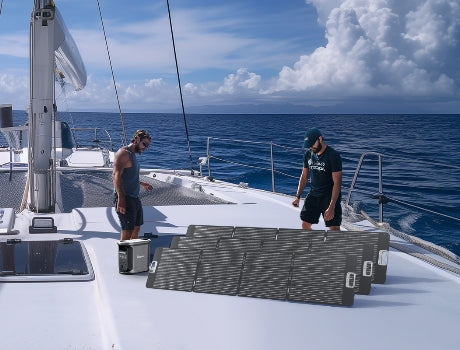
Power Backup
 Ampace - 2025-08-14
Ampace - 2025-08-14
The Secret to Sizing Your Solar System: A Practical Watts to Amps Guide
The right size for a solar system ensures you get enough power while avoiding unnecessary expenses. If your solar system is too small, it won't generate enough energy, and you might rely on the grid when you need it most. On the other hand, if it's too large, you will waste money on extra capacity you do not need. Proper sizing is key to getting a balance between performance and cost-efficiency. This process involves understanding how much energy you use and ensuring your system can provide the right amount without going overboard. A correctly sized system saves you money and reduces environmental impact by minimizing waste.
Why Solar System Sizing is Important
Sizing a solar system is a vital step before installation. The user must ensure that the system's capacity matches their power needs. If the solar system is too small, it won't generate enough energy, and the user will rely on the grid or run out of stored power when it's most needed.
On the other hand, if the system is too large, the user will waste a significant amount of money. Solar panels, batteries, and inverters all come at a cost. Paying for excess capacity can be financially burdensome. A correctly sized solar system strikes a balance: it provides energy without breaking the bank. Every component, from batteries to panels, will work at its best to deliver optimal energy. A well-sized solar system also proves to be beneficial in the long run. The user can save money by avoiding high electricity bills and reducing maintenance costs, as the system won't be over- or underused.
By properly sizing the system, the user can save hundreds or even thousands of dollars by cutting these extra costs. Proper sizing is also essential for the environment, as it ensures the user consumes only the energy they need, reducing waste. This makes the user's home or business more sustainable and eco-friendly.
Understanding Basic Electrical Terms
Before sizing a solar system, users need to understand basic electrical terms. Essential terms include watts, amps, and volts. A watt indicates the power a device consumes. For example, if a device is rated at 100 watts, it uses 100 watts per hour.
An amp measures the current flow, similar to how water flows through a pipe: the more amps, the more current flows through the pipe. A volt is the pressure that pushes electricity, similar to water pressure pushing water through a pipe.
The relationship between these three terms is simple:
Watts = Volts × Amps
This can be rearranged to:
Amps = Watts ÷ Volts
For example, let's say a user has a solar light that uses 60 watts and operates on 12 volts. Using the formula:
Amps = 60 ÷ 12
This means the solar light will use five amps of energy. This formula is key to sizing the solar system. If the user knows the wattage and voltage, they can calculate the amp usage of their devices.
Watts to Amps Conversion Formula
The Watts to Amps Conversion Formula is straightforward:
Amps = Watts ÷ Volts
This is the core step in solar system sizing, as it tells the user how much current their device draws from the system. That number is crucial for selecting the correct batteries, inverters, panels, and cables.
Why it matters for solar sizing:
Batteries are rated in amp-hours (Ah).
Inverters and charge controllers must be capable of handling the amps.
Cables must be thick enough to carry the current.
Therefore, converting watts to amps first is essential for accurate sizing.
Steps for Beginners:
1. Find the device's power in watts (check the label).
2. Choose the system voltage (12V, 24V, or 48V are common).
3. Divide the watts by the volts. The result will give the amps.
4. Use this amp number to select the correct battery Ah, inverter rating, and cable size.
Examples with steps:
Example A: 100 W device on a 10 V system.
Step 1: Watts = 100
Step 2: Volts = 10
Step 3: Amps = 100 ÷ 10 = 10 A
Example B: 300 W device on a 25 V system.
Amps = 300 ÷ 24 = 12.5 A
Example C: 600 W device on a 48 V system.
Amps = 600 ÷ 48 = 12.5 A
Factors That Affect Solar Sizing
Several factors influence the required size of a solar system. The first is the location and the number of sunlight hours. If the user lives in a sunny area, they will need fewer panels. However, if they live in a cloudy or rainy area with low sunlight, more panels will be required to generate the necessary energy.
Panel efficiency is another crucial factor. High-efficiency solar panels generate more energy in a smaller space. On the other hand, low-efficiency panels produce less energy, which can be useful for users with limited space to install panels. While lower-efficiency panels might be cheaper, they generate less output.
Battery storage is also critical. A larger battery can store more energy, ensuring the user has enough power at night or on cloudy days. A smaller battery means less backup power, requiring users to oversize their solar panels to compensate.
System voltage also plays a key role in sizing. A higher-voltage system, like 48V, requires fewer amps for the same wattage, reducing the need for thick cables and minimizing power loss. A lower-voltage system, such as 12V, requires more amps and thicker cables.
Sizing Your Ampace Solar Generator
Sizing your solar system correctly starts with understanding the conversion between watts and amps. For example, knowing how many amps it draws when you use the Ampace Andes 1500 Solar Generator will help determine how much energy it can supply for your devices. This solar generator offers up to 600W of solar input, perfect for off-grid activities like camping or RV trips. Calculating the watts and converting them to amps ensures you're using the right system to power your needs without excess capacity.
The Ampace Andes 600 Pro Solar Generator also follows this principle. With A-Boost technology, it charges from 0 to 80% in just 1 hour, offering up to 1800W of power. To understand how this system fits your requirements, knowing how to convert the watts into amps is essential. This process will guide you in choosing the right battery size, inverter, and cables. Whether you're using the Andes 1500 or 600 Pro, knowing the amps your devices use will help you optimise the system for better performance, longer lifespan, and maximum efficiency.
Common Mistakes in Solar Sizing
Many people make common mistakes when sizing their solar systems, leading to higher costs or inadequate power. One of the most frequent mistakes is neglecting inverter losses. Inverters convert DC power from the solar system into AC power for use in the home, but the process is not 100% efficient. Most systems lose around 5% to 10% of power during conversion. If the user doesn't account for this loss, the system will produce more energy than it can use effectively.
Another mistake is not accounting for future power needs. Over time, users may add more devices, appliances, or even electric vehicles. If the system is sized only for current usage, it will quickly become too small. Adding more solar panels in the future can be expensive.
A common mistake is failing to consider the challenges of different weather conditions. During the winter, the days are shorter, and the sun's angle is lower, reducing the amount of energy produced. If the system is designed only for summer conditions, it may struggle to meet energy demands in the winter months.
Lastly, many people rely solely on peak sun hours for their calculations. While this provides a general idea of the system's output, real-world factors like cloudy days, shade, and dust accumulation on the panels can reduce performance. Addressing these issues ensures a more reliable system that performs well year-round.
Conclusion
Sizing a solar system begins with understanding watts and converting them into amps. This simple step is vital for selecting the right panels, batteries, and inverters. Proper sizing ensures the user receives enough energy without wasting power on unnecessary capacity. It's also crucial to account for seasonal variations and future energy needs. By calculating the watts-to-amps conversion, users can determine their energy requirements and design a system that provides reliable power for years. A well-sized solar system saves money, reduces waste, and gives the user dependable energy for the long term.
FAQs
Why is solar system sizing so important?
Sizing your solar system properly ensures that you get enough energy to meet your needs without wasting money on unnecessary capacity. A system that is too small won't generate enough power, while one that's too large will cost you more than needed.
What are the basic electrical terms I need to understand?
The key terms are watts (the power a device uses), amps (the flow of electrical current), and volts (the pressure that drives the current). Understanding these helps you calculate your system's requirements and make informed decisions.
How do I convert watts to amps?
Use this simple formula: Amps = Watts ÷ Volts. This helps you understand how much current your device will draw, which is essential for selecting the right components like batteries, inverters, and cables.
What factors should I consider when sizing a solar system?
Location and sunlight hours, panel efficiency, battery storage, and system voltage all impact the solar system size you need. For example, a sunny area requires fewer panels, while cloudy areas need more to generate the same amount of energy.
What are common mistakes in solar sizing?
Common mistakes include neglecting inverter losses, not accounting for future energy needs, overlooking seasonal weather changes, and relying only on peak sun hours. These factors can lead to overpaying for excess capacity or underestimating the energy needed.
 Ampace - 2025-08-14
Ampace - 2025-08-14
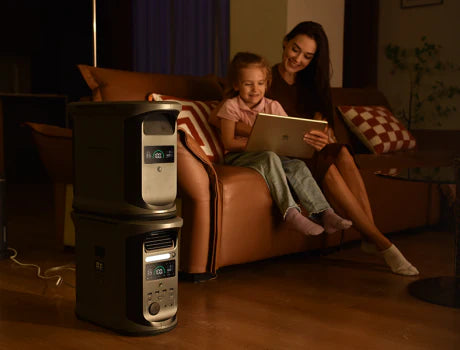
Complete Emergency Power Guide for Medical Needs: Beyond CPAP Machines
Imagine this scenario: the wind howls like a banshee, rain lashes against the windows, and the TV news ominously warns of a looming hurricane. Then, without a moment's notice, a sudden, unnerving silence descends as the power grid fails. For many, a power outage during hurricane season in the U.S. means a scramble for flashlights and a cold dinner. But for millions of Americans, especially those living in vulnerable coastal regions, losing electricity signifies an immediate and profound threat to their very health and well-being.
When the grid goes dark, it's about much more than just keeping your phone charged or preventing ice cream from melting. For individuals relying on crucial medical equipment, an extended power loss isn't merely an inconvenience; it becomes a critical, life-threatening emergency. We’re talking about devices that maintain breathing, regulate body functions, or keep vital medications viable. It’s a situation where minutes can literally matter. This comprehensive guide will walk you through everything you need to know about securing a reliable emergency power supply for all your essential medical needs during severe weather events.
The Silent Threat – Understanding Medical Device Dependency in a Power Outage
The danger of a power outage for someone with medical needs is often overlooked by those who don't face such challenges daily. It's a silent threat, creeping in with the loss of every essential hum and whir of life-sustaining machinery.
Why Power is Life-Saving for Various Medical Needs
While the CPAP machine is probably the most commonly recognized power-dependent medical device, the spectrum of critical equipment is far wider. For sleep apnea patients, a continuous positive airway pressure (CPAP) machine ensures open airways, preventing potentially fatal breathing interruptions during sleep. Without power, that lifeline is severed.
But let's think beyond the CPAP:
Oxygen Concentrators: These devices provide essential oxygen therapy. For individuals with severe respiratory conditions, the immediate danger of a power loss to an oxygen concentrator cannot be overstated. It's a matter of immediate breath.
Nebulizers: Used to administer medication in mist form for conditions like asthma or COPD, these also require power. A flare-up during an outage without a working nebulizer can quickly escalate.
Ventilators: For those on life-support systems, a ventilator provides mechanical assistance for breathing. Powering such a device is not just crucial; it's absolutely non-negotiable for survival.
Insulin and Other Refrigerated Medications: Many life-saving medications, including insulin, certain antibiotics, and biological drugs, require constant refrigeration. Fluctuations in temperature can render them ineffective or even dangerous. The simple act of keeping your refrigerator running becomes a critical medical task.
Mobility & Support Devices: Electric wheelchairs, scooters, feeding pumps, lift chairs, and even hearing aid chargers are all dependent on electricity. Losing power can mean losing mobility, access to nutrition, or essential communication capabilities.
The risks associated with power loss for these devices are profound: rapid health deterioration, spoilage of vital medications, and a significant loss of independence or access to basic care. A thorough understanding of these dependencies forms the bedrock of any effective emergency plan.
Assessing Your Vulnerability: The Medical Power Audit
Just as we might conduct a home energy audit to save money, a "medical power audit" focuses on saving lives. This isn't merely about convenience; it's about survival. You need to create a detailed, meticulous list of all medical equipment your household relies on, no matter how small it may seem.
For each piece of equipment, note down:
Running Watts: This is the continuous power the device consumes while actively operating. (e.g., a CPAP machine might use 30-60 watts).
Starting Watts (or Surge Watts): For devices with motors (like some oxygen concentrators or nebulizers), there's a brief, higher power draw when they first turn on. Your emergency power source must be able to handle this momentary surge.
Daily Usage Hours: How many hours a day does each device typically run? This is crucial for calculating your total daily energy consumption in watt-hours (Wh). For instance, a 60-watt CPAP used for 8 hours needs 480 Wh (60W x 8h).
Backup Needs: This is the most critical issue. How many hours or, more realistically, how many days of power do you absolutely need to sustain these devices safely? During a major hurricane, power could be out for days, even weeks. Plan at least 3-7 days of sustained power for critical medical devices.
This detailed inventory helps you understand the scale of your power needs, guiding you toward the correct emergency power supply solution.
Choosing Your Lifeline – Emergency Power for Medical Equipment
With your medical power audit complete, the next crucial step is to select the right emergency power for medical equipment. This decision is paramount, and it’s where safety, reliability, and functionality intersect.
The Quest for a Reliable Emergency Power Supply
When selecting an emergency power supply, especially for sensitive medical devices, compromise isn't an option. You need a system that's not only powerful enough but also safe for indoor use and capable of delivering clean, stable electricity. The hum of a generator might seem reassuring, but its fumes can be deadly if not handled correctly.
The Clean & Safe Choice: No-Fume Emergency Power Source Options
For indoor use, particularly when dealing with respiratory equipment or sensitive electronics, a no-fume emergency power source is the only safe and responsible choice.
Solar Generators Pros and Cons (Portable Power Stations with Solar Panels):
Pros:
These are rapidly becoming the go-to solution for medical backup.
They operate silently, produce zero harmful fumes, making them perfectly safe for indoor use, even right next to a bed.
They recharge using renewable solar energy, offering true independence, and require minimal maintenance.
Cons:
Their primary limitation is their reliance on sunlight for recharging.
During prolonged cloudy periods or intense storms (like a hurricane!), their charging efficiency will be severely impacted.
The upfront cost can also be higher than a traditional generator, and their capacity might be limited for very high-draw devices if not sized appropriately.
Ideal Use:
Perfectly suited for continuous-run devices like CPAP machines, most oxygen concentrators (though ensure sufficient capacity for longer runtimes), and keeping smaller medical devices charged. They can also help power a refrigerator with careful use (more on that later). Ampace Power offers a range of robust, no-fume solar generators designed for reliable backup.
Battery Backup Systems (UPS/Portable Power Stations):
Pros:
Many portable power stations function as a powerful, large-capacity battery backup.
Uninterruptible Power Supplies (UPS) provide virtually instantaneous power transfer, preventing any disruption to sensitive equipment.
Like solar generators, they are completely silent and produce no fumes, making them safe for any indoor environment.
Their portability means you can easily move them to where they're needed most.
Cons:
They are limited by their stored charge.
Once depleted, they require recharging from a grid connection (if power returns), solar panels, or a traditional generator.
Higher capacity units can be heavy, but typically offer wheels or handles for easier movement.
Best Use:
Ideal for critical short-term needs, bridging the gap until primary power returns, or providing continuous power for smaller, sensitive loads without any interruption. Think of them as your immediate, silent guardian against outages.
Inverters with Car Batteries: In desperate situations, some might consider using a power inverter connected to a car battery. While technically feasible for very short-term, low-power needs, this is a less ideal and riskier solution. Car batteries aren't designed for deep cycling (repeatedly discharging deeply), which can quickly damage them. Furthermore, running a car to charge the battery produces dangerous carbon monoxide fumes, so it must be done outdoors. It's an inefficient, noisy, and potentially hazardous option best reserved for absolute emergencies and very short durations.
Traditional Gasoline/Propane Generators (with major caveats)
Traditional portable generators, typically running on gasoline or propane, offer a high power output for a relatively lower upfront cost. They can indeed power a wide range of appliances.
Crucial Safety Warning: Traditional generators must ALWAYS be operated outdoors, far away from windows, doors, and vents. The exhaust contains carbon monoxide, an odorless, colorless, deadly gas. Never, under any circumstances, run a traditional generator inside your home, garage, shed, or even too close to an open window. The CDC has comprehensive generator safety guidelines that you should review.
Pros: High power output, often capable of running multiple large appliances. Fuel (if properly stockpiled) can be readily available.
Cons: Noisy, produces toxic fumes, requires careful fuel storage, and might not provide the "clean" power (pure sine wave) needed for sensitive electronics unless specifically designated as an "inverter generator."
Best Use:
For charging larger battery banks of solar generators, powering outdoor appliances, or running heavy-duty items that absolutely cannot be powered by a no-fume source, always with strict adherence to outdoor operation.
Protecting Your Essentials – Home Power Backup System for Refrigerator
When the power goes out, it's not just medical devices that become critical. For households with medical needs, a functioning refrigerator can be just as vital, preserving life-saving medications and ensuring food safety.
Beyond Medical: Why Food and Medication Preservation Matters
The loss of refrigeration during a power outage carries dual risks. Firstly, for individuals needing medications like insulin, specific eye drops, or certain injectables, maintaining a constant low temperature is paramount. Temperature excursions can render these medications ineffective, leading to dangerous health outcomes. Secondly, a spoiled refrigerator full of food can lead to additional health risks from foodborne illnesses, further complicating an already stressful emergency situation. Planning for a home power backup system for refrigerators is therefore a fundamental part of comprehensive medical preparedness.
Keeping Cool: Options for Your Refrigerator During an Outage
Portable Power Stations (Solar Generators): Many modern refrigerators are surprisingly energy-efficient, often only drawing power in short bursts throughout the day. A well-sized portable power station (which is essentially the battery component of a solar generator) can keep a standard refrigerator running for 1-3 days, depending on its capacity and your fridge's efficiency. You'll need to calculate its running watts and factor in its "on-cycle" duration. Emphasize the need for a unit with sufficient battery capacity (Watt-hours or Wh) to last for multiple days, and ensure it has a pure sine wave inverter to protect your appliance.
Whole-Home Battery Storage Systems: For those seeking the ultimate peace of mind, a professionally installed whole-home battery storage system (like Tesla Powerwall or similar) can provide seamless, silent, and automatic backup for your entire house, including your refrigerator and all medical equipment. However, be aware of the significant upfront cost and complex installation involved.
Traditional Generators (outdoor only): As a primary source, a traditional generator can easily power your refrigerator. But, as always, remember the strict rule: outdoor operation only to prevent carbon monoxide poisoning.
Low-Tech Solutions: Don't underestimate the power of simple preparedness. Keep your refrigerator and freezer doors closed as much as possible to trap cold air. A full freezer stays cold longer than an empty one, so consider filling empty spaces with ice bags or frozen water bottles. Insulated coolers with plenty of ice can also serve as a temporary "medical fridge" for critical medications. Strategically moving contents to the coldest parts of your fridge/freezer can extend their viability. The USDA provides excellent guidelines on food safety during power outages, which is essential reading.
Proactive Preparedness – How to Prepare for a Long Power Outage
Understanding how to prepare for a long power outage, especially when medical needs are a factor, goes far beyond just securing an emergency power supply. It requires a holistic, multi-layered approach to hurricane preparedness that touches on every aspect of daily life.
The Multi-Layered Approach to Hurricane Preparedness
Effective preparedness isn't about scrambling at the last minute; it's about thoughtful, consistent planning. During hurricane season, this vigilance becomes even more critical.
Communication Plan:
Ensure all phones are fully charged before the storm hits.
Consider purchasing portable chargers or small power banks for phones.
Invest in walkie-talkies for short-range communication within your household or immediate neighborhood if cell towers go down.
A battery-powered or hand-crank NOAA weather radio is indispensable for receiving emergency alerts and updates when other communication methods fail.
Designate an out-of-state contact person who everyone in your family can check in with. This way, if local lines are down, messages can be relayed through a trusted third party.
Water Supply:
Store at least one gallon of water per person, per day, for several days. Aim for a minimum of three days, but ideally more for hurricane-prone areas.
Consider water purification tablets or a portable water filter for additional safety.
Fill bathtubs with water for flushing toilets.
Food Storage:
Stock up on non-perishable food items that require no cooking or refrigeration (canned goods, dried fruits, nuts, energy bars).
Don't forget a manual can opener!
Have safe cooking alternatives like a camping stove or propane grill for outdoor use only.
Lighting:
Flashlights with extra batteries are a must. Headlamps are incredibly useful for hands-free lighting.
Solar-powered lanterns or crank lanterns offer sustainable light sources.
Crucial Safety Tip: Avoid using candles, especially during a hurricane when gusty winds could cause them to tip over, leading to fire hazards.
First Aid Kit: Beyond a standard kit, tailor yours to include any specific medical supplies your household requires (e.g., extra prescription medications, wound care supplies for specific conditions, diabetic testing supplies). Consider a paper copy of all prescriptions.
Cash: ATMs and credit card machines won't work without electricity. Have enough small bills on hand for several days' worth of necessities.
Important Documents: Keep copies of critical documents (IDs, insurance policies, medical records, medication lists) in waterproof bags and a secure, easily accessible location. Consider digital copies on a flash drive that can be powered by your emergency power supply.
Testing Your System: The Mock Outage Drill
Knowing how to prepare for a long power outage isn't just about accumulating supplies; it's about preparedness through practice. Advise readers to conduct a "mock outage drill" before a real emergency strikes. This involves:
Practicing System Setup: Set up your emergency power supply (solar generator, battery backup, or traditional generator) and connect your critical medical equipment.
Testing Run Times: Observe how long your devices run on your backup power. This helps you verify your power audit calculations and identify any weak points in your system.
Familiarity for All: Ensure everyone in the household, especially those who might need to operate the system, knows how to safely start, connect, and manage the backup power. This hands-on experience builds confidence and efficiency when it matters most.
This proactive approach can turn a potentially chaotic and dangerous situation into a manageable inconvenience, providing invaluable peace of mind.
Conclusion:
Hurricane season in the United States brings unpredictable challenges, but with careful planning, the threat of blackouts for those with medical needs can be significantly mitigated. By following this comprehensive guide, you’ve taken critical steps towards securing your family's safety. You've learned the vital process of assessing your specific medical equipment's power demands through a detailed audit, understood the absolute necessity of choosing safe and reliable no-fume emergency power source options, and grasped the importance of a robust home power backup system for refrigerators for medication and food preservation. Ultimately, knowing how to prepare for a long power outage is about implementing a multi-layered, holistic family preparedness plan that accounts for all eventualities.
Don't wait for the next storm to loom large on the horizon. Act now to secure your emergency power for medical equipment and ensure your household is resilient in the face of any power disruption. Proactive planning is your most powerful tool, transforming potential disaster into manageable inconvenience and empowering your safety and well-being. Reliable emergency power supply solutions, including high-quality solar generators and backup batteries designed for critical situations, are available through trusted providers like Ampace Power. Equip yourself today, and face tomorrow's uncertainties with confidence.
Frequently Asked Questions (FAQs)
How long can a solar generator power a CPAP machine during an outage?
The run time depends on the solar generator's battery capacity (measured in Watt-hours, Wh) and your CPAP machine's wattage (typically 30-60W). A CPAP without a humidifier uses less power. A 500Wh solar generator could power a 30W CPAP for roughly 16 hours, while a 1000Wh unit could last over 30 hours. Always check your specific CPAP's wattage and the generator's capacity.
Are traditional gas generators safe to use inside a garage or house?
Absolutely not. Traditional gasoline or propane generators produce dangerous carbon monoxide (CO) fumes, which are odorless and colorless but can be fatal. They must always be operated outdoors, at least 20 feet away from your home, windows, and vents. For indoor power, use a no-fume emergency power source like a battery backup or solar generator.
Can a small portable powerhouse keep my insulin refrigerated for days?
It depends on the power station's capacity and your refrigerator's efficiency. A small portable power station (e.g., 500Wh-1000Wh) might keep a mini-fridge or a medical cooler running for 1-2 days if managed carefully (minimizing door openings). For a standard home refrigerator, you'll need a larger portable power station (2000Wh+) or a solar generator with sufficient battery capacity to last several days. Always perform a power audit for your specific fridge to confirm.
What's the most critical equipment to consider for emergency medical power?
The most critical piece of equipment is anything that directly supports a life-sustaining function or preserves vital medication. This includes, but is not limited to, oxygen concentrators, ventilators, and power for refrigerated medications like insulin. Your personal medical power audit will help you identify your specific critical devices.
How often should I test my emergency power backup system?
You should test your emergency power supply at least once every three to six months, and ideally before the start of hurricane season. This includes fully charging the unit, connecting your essential medical devices, and running them for a short period to ensure everything functions correctly. Also, check fuel levels for traditional generators and ensure solar panels are clean and operational.
What other non-power related items are essential for hurricane preparedness when relying on medical equipment?
Beyond power, essential non-power items include a comprehensive, personalized first aid kit (with extra prescription medications), a battery-powered or hand-crank NOAA weather radio, a multi-day supply of non-perishable food and water, flashlights (no candles!), and copies of all important medical documents and prescriptions in a waterproof bag. Having an out-of-state contact for communication is also crucial.
 Ampace - 2025-08-14
Ampace - 2025-08-14
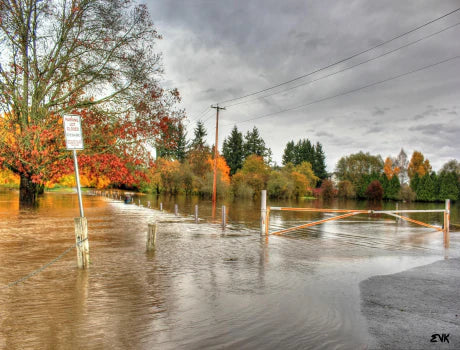
Comprehensive Guide to Flood Preparedness in the USA
Floods are among the most common and destructive natural disasters in the United States, causing significant property damage and posing risks to personal safety. This guide explores the causes of floods, where they can occur, the types of floods, recent flood events in the USA, how to check your flood zone, and practical steps to prepare your home.
What Causes Floods?
Floods occur when water overflows onto land that is typically dry, often due to excessive water input or disrupted drainage systems. Common causes include:
Heavy Rainfall: Prolonged or intense rain can overwhelm rivers, streams, and drainage systems, leading to overflow.
Snowmelt: Rapid melting of snow, especially in spring, can increase water levels in rivers and streams.
Storm Surges: Coastal storms, hurricanes, or tsunamis can push seawater inland, flooding coastal areas.
River and Dam Overflows: Excessive water flow or structural failures in dams can lead to flooding downstream.
Urban Development: Impervious surfaces like pavement prevent water absorption, increasing runoff and flood risk.
Climate Change: Rising sea levels and more frequent extreme weather events exacerbate flooding risks.
Where Floods Can Strike
You might think floods are just for coastal cities or river towns, but the reality is broader. The National Weather Service says it best: “Where it can rain, it can flood.” Coastal areas like Florida or Louisiana face storm surges, but inland regions aren’t safe either. Arkansas saw this in April 2025, when storms turned communities into lakes. Even hilly areas can face flash floods, where water races through canyons or small streams in minutes. Urban areas, with their concrete-heavy landscapes, often can’t drain fast enough during heavy rain.
Flood-prone spots include:
Coastal Zones: At risk from hurricanes and rising seas.
River Basins: Like the Mississippi, where overflows are common.
Urban Centers: Poor drainage systems lead to pooling water.
Low-Lying or Hilly Areas: Prone to pluvial or flash floods.
The Many Faces of Floods
Floods aren’t one-size-fits-all—they come in different forms, each with its own challenges. Imagine a sudden torrent turning a city street into a river in hours; that’s a flash flood, like those that hit the Midwest in July 2025. Or picture a river slowly spilling over its banks after days of rain, lingering for weeks. Coastal floods, urban floods, and even rare dam failures all bring unique threats. Knowing the type of flood you might face helps you prepare smarter.
Here are the key types to understand:
Flash Floods: Fast and furious, triggered by heavy rain, often in urban or hilly areas.
River Floods: Slow-building, caused by prolonged rain or snowmelt, affecting river valleys.
Coastal Floods: Driven by storm surges or tsunamis, hitting shorelines hard.
Urban and Pluvial Floods: Caused by poor drainage or surface water in cities and flat areas.
Dam/Levee Failures: Rare but catastrophic, releasing massive water flows.
Recent Flood Events in the USA
Recent flooding events highlight the ongoing risk across the United States:
July 2025, Texas: Severe flash flooding struck Texas on July 4, 2025, causing significant property damage and prompting widespread emergency responses. The event underscored the need for preparedness during hurricane season.
July 2025, Midwest: Flash flooding occurred from northeast Kansas to Indiana due to heavy rains, with scattered instances reported. These events disrupted communities and infrastructure.
April 2025, Arkansas: Severe storms led to widespread flooding, affecting homes and businesses. The Arkansas Department of Emergency Management reported extensive damage, emphasizing the importance of flood insurance and preparedness.
These incidents reflect the diverse and frequent nature of flooding, driven by seasonal weather patterns and climate variability.
Know Your Risk: Checking Your Flood Zone
Before a flood catches you off guard, find out if your home is in harm’s way. Start with FEMA’s Flood Map Service Center online—enter your address to see if you’re in a high-risk zone (like Zone A or AE), moderate-risk (Zone B), or lower-risk (Zone X). But maps aren’t the whole story. Floods can hit anywhere, so check with your local emergency management office for specifics on flash flood or landslide risks. If you’re in a high-risk area, flood insurance through the National Flood Insurance Program (NFIP) is a must, and it takes 30 days to activate, so don’t delay.
Here’s how to get started:
Use FEMA’s Tools: Visit the Flood Map Service Center or National Risk Index for risk details.
Contact Local Authorities: Get insights on local flood patterns or vulnerabilities.
Plan for Insurance: Secure an NFIP policy to cover flood damage, as standard homeowner’s insurance won’t.
Building a Flood-Ready Home
When flood warnings light up your phone, a prepared home can be your stronghold. Think of it like battening down the hatches before a storm. Elevate appliances like your furnace or water heater above your area’s flood level to keep them dry. Install a sump pump with a battery backup to fight rising water, and consider backflow valves to block sewage. Outside, secure fuel tanks and tie down loose items like patio furniture to keep them from floating away. Stock an emergency kit with essentials—food, water (a gallon per person and pet daily), medications, and a NOAA weather radio—for at least three days, or two weeks in high-risk areas.
Power outages often come with floods, and that’s where an Ampace Portable Power Station steps in. These devices, like the Andes 600 Pro or Andes 1500, can keep your fridge running, charge your phone, or power medical equipment. With up to 6kWh capacity and solar charging options, they’re versatile for home or evacuation. Here’s why they’re a game-changer:
Reliable Power: Run critical devices during outages, from radios to refrigerators.
Portable and Flexible: Compact for storage or travel, with AC and solar charging.
Emergency Ready: Keep communication tools or medical devices operational.
With these steps, your home becomes a safer haven when waters rise.
After the Flood: What to Do in the First Week
When the floodwaters retreat, dangers can still linger. The first week is critical for staying safe, preventing further damage, and beginning recovery. Here's what to focus on:
Stay out of floodwater: It may contain sharp debris, chemicals, or live wires.
Avoid using utilities: Wait for professionals to inspect gas and electrical systems.
Dry your home quickly: Mold can start growing within 48 hours.
Boil or treat tap water: Unless authorities say it’s safe.
Document damage: Take photos before cleanup for insurance claims.
Use power stations safely: Keep your Ampace unit dry and elevated during use.
Powering Through with Ampace
An Ampace Portable Power Station is a critical lifeline when floods disrupt the power grid.
Ampace Andes 1500
The Andes 1500 delivers 2,400W continuous power (3,600W surge) with a 1,462Wh LiFePO4 battery, powering essentials like refrigerators or medical devices for hours. Its 13 ports (AC, USB-C, car outlets) support multiple devices, and it recharges in 55 minutes via AC or 3-5 hours with up to 600W solar panels. Built for extreme conditions (-20°C to 45°C), with a smart app for remote monitoring, it’s ideal for home backup or off-grid flood recovery.
Ampace Andes 600 Pro
The compact Andes 600 Pro offers 600W continuous power (1,800W surge) with a 584Wh LiFePO4 battery, charging smartphones (~30 times) or laptops (~7 times). With 9 ports (AC, USB-C, DC), it’s perfect for short outages or evacuation. It charges to 80% in 1 hour via AC or 3-5 hours with 200W solar panels. Weighing 16.8 lbs, with an LED flashlight and app-controlled lights, it ensures portability and visibility in flood conditions.
 Ampace - 2025-08-11
Ampace - 2025-08-11
Page 1 of 7






